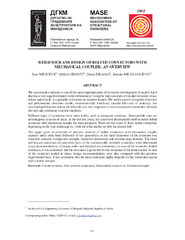Приказ основних података о документу
Behaviour and design of bolted connectors with mechanical coupler: an overview
| dc.creator | Milićević, Ivan | |
| dc.creator | Vidović, Milica | |
| dc.creator | Dragaš, Jelena | |
| dc.creator | Milosavljević, Branko | |
| dc.date.accessioned | 2023-10-11T09:57:12Z | |
| dc.date.available | 2023-10-11T09:57:12Z | |
| dc.date.issued | 2023 | |
| dc.identifier.isbn | 978-608-66946-3-0 | |
| dc.identifier.uri | https://grafar.grf.bg.ac.rs/handle/123456789/3220 | |
| dc.description.abstract | The construction industry is one of the most important parts of economic development of society but it also has a very negative impact on the environment. Using the three concepts of circular economy: reuse, reduce and recycle, it is possible to decrease its negative impact. The steel-concrete composite structures and prefabricated structures enable, environmentally beneficial, circular life-cycle of buildings. For structural performance during the lifecycle, it is very important to have an adequate connection between the steel and reinforced concrete members. Different types of connectors have been widely used in composite structures. Demountable ones are advantageous in terms of reuse. In the last few years, the innovative demountable steel-concrete bolted connector with mechanical coupler has been proposed. There are two types of these bolted connectors depending on the type anchorage i.e., with the rebar anchor or with the second bolt. This paper gives an overview of previous research of bolted connectors with mechanical coupler capacity under static load. Influence of key parameters on the shear behaviour of the connector was observed: concrete compressive strength, connector dimensions and concrete edge distance. The shear and tension resistances of individual parts of the commercially available connectors were determined using recommendations of design codes and technical documentation. In case of the connector loaded in tension, it was concluded that the resistance is governed by the resistance of the rebar anchor. In case of the connector loaded in shear, design recommendations were also compared with the previous experimental tests. It was concluded that the shear resistance highly depends on the connection layout and concrete strength. | sr |
| dc.language.iso | en | sr |
| dc.relation | info:eu-repo/grantAgreement/MESTD/inst-2020/200092/RS// | sr |
| dc.rights | openAccess | sr |
| dc.rights.uri | https://creativecommons.org/licenses/by-nc-nd/4.0/ | |
| dc.source | Proceedings of the 20th International Symposium of the Macedonian Association of Structural Engineers (MASE), Skopje, September 28-29, 2023. | sr |
| dc.subject | Circular economy | sr |
| dc.subject | Steel-concrete connections | sr |
| dc.subject | Demountable connections | sr |
| dc.subject | Mechanical coupler | sr |
| dc.title | Behaviour and design of bolted connectors with mechanical coupler: an overview | sr |
| dc.type | conferenceObject | sr |
| dc.rights.license | BY-NC-ND | sr |
| dc.rights.holder | MASE -Macedonian Association of Structural Engineers | sr |
| dc.citation.epage | 680 | |
| dc.citation.spage | 671 | |
| dc.identifier.fulltext | http://grafar.grf.bg.ac.rs/bitstream/id/12152/bitstream_12152.pdf | |
| dc.identifier.rcub | https://hdl.handle.net/21.15107/rcub_grafar_3220 | |
| dc.type.version | publishedVersion | sr |

